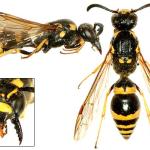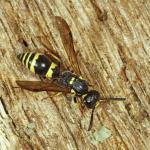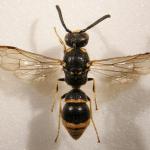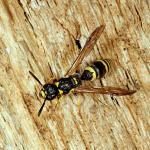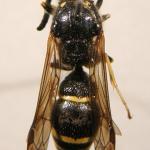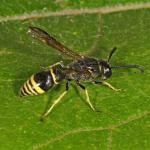Identification keys, distribution and general biology are given in Spradbery (1973), Richards (1980), Yeo and Corbet (1995), and Falk (1991).
Principally a southern species, with an isolated record from south-east Yorkshire. Although this wasp is widespread there are few records, especially since 1950.
The species is listed as Rare (RDB3) in Shirt (1987) and Falk (1991).
Adults seem to prefer damp places, often near streams and ditches (Guichard 1972), and their flight paths are associated with patches of foliage in full sunlight.
Late June, July and early August; sometimes early June and late August.
Larvae of the chrysomelid beetle Chrysomela populi.
Species of Symmorphus are tube-nesters, using existing cavities such as plant stems, e.g. bramble and elder; vacated burrows of wood-boring insects; straws of thatched roofs; old walls; and even vertical sand banks. When a suitable nesting site has been found, the female clears away any remaining pith and debris. Next she collects clay which is softened with water stored in her crop. Often, a preliminary plug of clay is placed at the end of the burrow before the cells are built. The clay partitions between the cells have a rough, convex inner surface and a smooth, concave outer surface, which probably helps the full-grown larva to orientate itself for its eventual escape as an adult from the cell (as in most, if not all, aculeates with a similar life cycle). The cells are arranged linearly. An egg is laid in each cell before the cell is provisioned.
The prey is immobilised by stinging and carried by the mandibles and forelegs (cf S. connexus). Prey are packed tightly in the cell, avoiding the egg. Usually, the egg takes two or three days to hatch, with the larval stage taking one to two weeks with probably five instars. When feeding is completed the larva may rest for about a day and voids its gut contents at the inner end of the cell before spinning a cocoon which is anchored at the base of the cell. When the species is univoltine, the prepupal stage lasts for six to eight months, the pupal stage for one week and the newly emerged adult rests in the cell for two to three weeks before emerging. When the species is multivoltine, the prepupal stage lasts about one week.
Figwort, umbellifers (Apiaceae) and spurge.
Chrysis fulgida has been found associated with S. crassicornis in Europe (Schneider 1991).
1997


